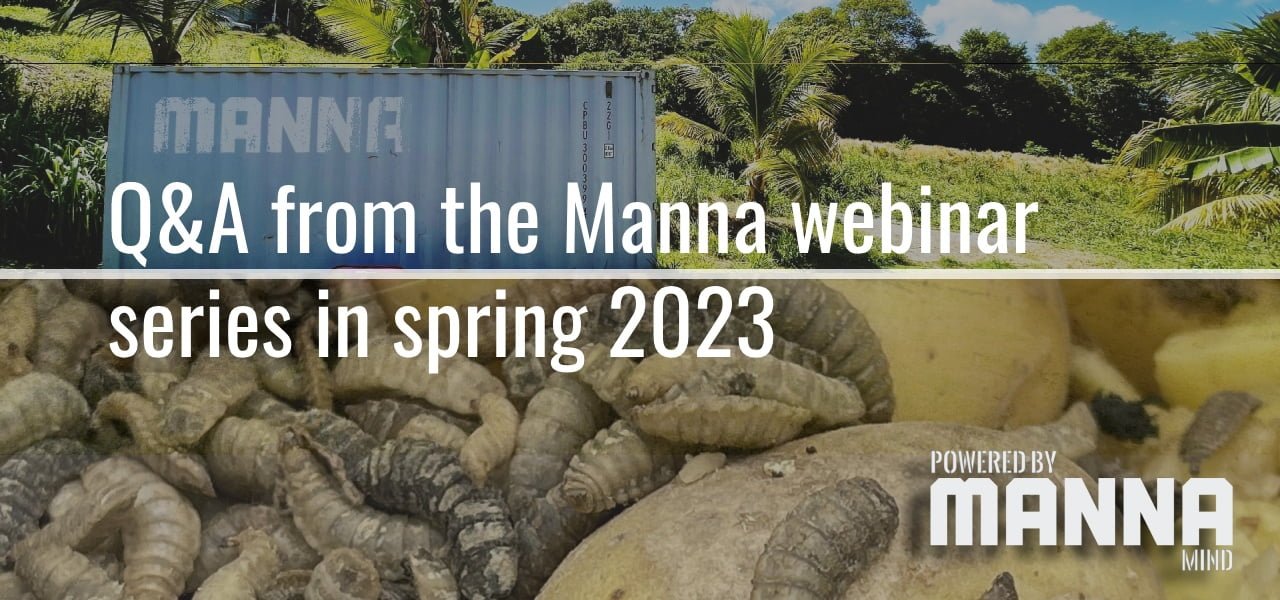
Q&A from the Manna webinar series in spring 2023
In this long post we answer the questions that came up during the Manna Insect Free Webinar series in spring 2023. The questions have been divided in nine categories as listed below, so you can simply jump into your area of interest via the links below.
If you hadn’t a chance to participate in the webinars, but would like to see the recordings of them, just fill this form and you’ll receive a link to all the recordings!
Manna containers, MIND unit and process environment
Manna solutions key purpose is to provide the best possible environment for BSF to grow and breed. Even in tropical climates weather conditions and humidity can change a lot during day and night and there are colder and warmer seasons all around the year. Inside Manna containers the artificial climate is optimal all the time for BSF, and it is adjusted during the rearing cycle. Purpose is to reach optimal results; get full grown large larvae and consume all biomaterials during the growing process.
BSF larvae related questions
Organic waste / substrate recipe and handling
This is something that depends very much on what kind of biomass you are using and where it comes from. The most optimal way is to have the containers next to a biomass source (or storage) which produces enough substrate for the containers that you have and you can use it in batches, up to 4 ton per container in each 10 day breeding cycle.
The standard process is to load each container full at once and then run the 10 day breeding cycle, but it’s also possible to load it during three consecutive days and then start the cycle. For example, if you have roughly 1 ton of biowaste every day, you fill one container within 3 days (1tn+1tn+1tn) and then start the rearing cycle. For a continuous process you’d need 4 breeding containers.
There is no point in that, other than learning and practising scalable rearing and breeding while we can really use the non-usable biowaste.
We have been testing all kinds of substrates, and in general BSFL happily eat pretty much anything organic, as long as the moisture level is favourable. However, for the process to be most efficient, the substrate should be as homogeneous as possible. This means that in case of several different sources of biowaste, you’ll need to pay extra attention to the recipe of the substrate; how to mix the waste and how to keep it homogenous.
In the batch model biowaste is not added on a daily basis, so storing the waste is needed and enables mixing different waste components. Without further information and analysis of the waste we can’t comment on the composition of the end product, but it’s clear that the quality of the substrate affects the composition / nutritional value of the final product.
The biowaste price can vary greatly depending on the country and the source. In general developed countries have more restrictive legislation that increases the price of the substrate. The price often also highly depends on the logistics – the closer the biowaste comes from, the cheaper the transportation costs are. In some cases biowaste can be totally free too, and it’s even possible that the BSF the farmer is paid for receiving and processing biowaste.
In the webinar we gave three rather extreme examples of the pricing; in western context 40 $ per ton, in Asian context 5 $ per ton and in African context 3 $ per ton.
Frass / organic fertiliser
The price of frass and frass products varies a lot depending on the scenario and the end customer, as well as the post-processing level / the end product. The quality and therefore also the average price for BSF frass varies significantly due to a number of factors, but we’ve collected frass prices for our database from publicly available sources from companies and individuals who sell BSF frass directly to end users online (retail, not wholesale), meaning that the prices below are NOT comparable to the price you would get when selling in masses (to big clients who buy tons of frass at a time). In Europe the average price for frass when sold in small bags was 1 538 euros per ton, in the US 11 919 euros per ton, in Asia 6740 euros per ton and in Kenya 373 euros per ton.
Read more about frass and the pricing of it in our article about frass as a business opportunity.
Rearing and breeding processes
Pre- and post-processing
Business model related questions
For a thorough answer to this question, please go through our article series about the benefits of BSF based feed compared to soy feed. As a short answer, BSF feed is or can be more sustainable and more cost-efficient, and the nutritional value and amino acid profile of BSFL is great.
Furthermore, BSF larvae are easy to rear and have a high yield, but only require minimal land area. Using BSFL also reduces the competition with human food, since at the moment huge majority of soy production is used as animal feed, but the use of soybean in human consumption is expected to grow.
The BSF business is still very young globally, and at this point there is no clear market price yet, at least not a global one. Also at the regional level the prices can vary greatly. There are not many studies on how many kilos of live larvae would you need to feed to a chicken to replace one kilo soy meal.
An estimation based on research is that it is between 2-3 kilos. 2,5 kilos of live larvae compared to one kilo of soymeal would mean that price is around the same level, or little bit less for the live larvae, especially in developing countries. In some areas the business is more lucrative than others, as also the price of soy varies.
Sustainability
Legislation and restrictions
The next Manna Insect Webinar series begins in August 2023 – take a look at the topics and the schedule, and register in these free webinars!
